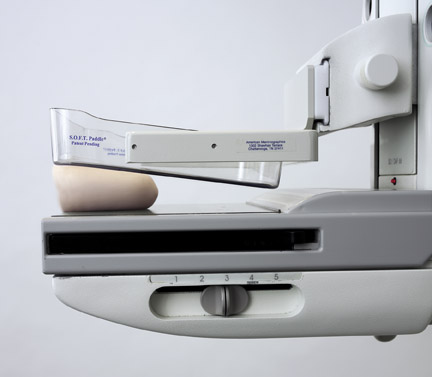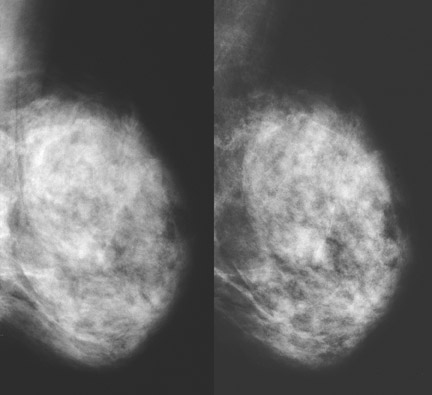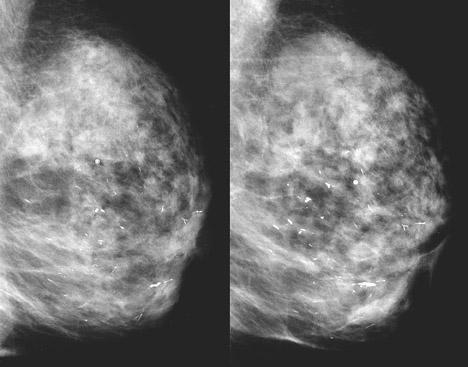Will Digital Replace Film-Screen Mammography?
Images



Dr. Hixson is a Women's Imaging Specialist in Chattanooga, TN and the founder of American Mammographics, Inc.
There have been four screening trials comparing full-field digital mammography (FFDM) and film-screen mammography (FSM). 1 None of these trials showed a significant difference in the diagnostic accuracy between the two in the population as a whole. The latest trial was the ACRIN study (DMIST), which compared FFDM with FSM in 42,760 women. 1 DMIST showed that FFDM had some increased sensitivity in heterogenously dense or extremely dense breasts (mainly for DCIS).
Awareness of the limitations of DMIST and the other three trials will allow more meaningful scrutiny of their results and conclusions. The various types of bias or limitations in scientific investigations have recently been comprehensively described. 2 When a new test is evaluated, its efficacy is determined by comparing its performance to that of the accepted reference test. The Kodak Min-R 2000 Screen-Film System (Kodak Health Imaging Group, Rochester, NY) was used exclusively in the first three trials and at the majority of the DMIST sites. However, since DMIST was conducted, there has been significant improvement in mammographic film-screen technology that now utilizes a double-emulsion film. The Kodak MIN-R EV Screen-Film System has replaced the MIN-R 2000 system as the company's premium system. This means that the new state-of-the-art film-screen technology, such as the Kodak MIN-R EV System, has become the new reference standard to which FFDM must be compared. The results of DMIST or any other comparison study are open to question if the reference standard is no longer valid.
Optimizing Film-Screen Mammography
The S.O.F.T. Paddle ® is one of several recently developed products that can enhance the performance of FSM. A conventional compression paddle produces optimum compression of only the thick posterior portion of the breast. Several compression paddles have been developed that rotate as compression is applied. They tilt downward over the anterior breast but, at the same time, they rotate upward posteriorly. Unfortunately, this causes suboptimal compression of the posterior breast, which is where most cancers occur.
The S.O.F.T. Paddle ® from American Mammographics is different (Figure 1). The compression surface is horizontal near the chest wall, then curves slightly to slope downward toward the nipple. It does not rotate. Increased compression of the anterior two-thirds of the breast is achieved while maintaining excellent compression posteriorly. Fibroglandular tissue is spread apart more effectively so that a cancer is less likely to be obscured by superimposed structures. There is additional reduction in breast thickness. This permits a lower kV, which increases contrast. Exposure time is also shortened, which eliminates motion blur. The improved image quality with S.O.F.T. Paddle ® is shown in Figure 2. S.O.F.T. Paddle ® provides many potential benefits, such as increased sensitivity for cancer detection and fewer callbacks (Table 1).
Dr. László Tabár says of the S.O.F.T. Paddle ® , "the image details that are so essential in making the first and most important decision (callback or normal) are visualized so well and with such a sharpness as I have never experienced it previously." 3
New state-of-the-art FSM systems produce higher contrast that will increase detection of cancers in denser breasts. The Kodak MIN-R EV system utilizes a new double-emulsion film and a single improved intensifying screen with smaller, more densely packed phosphor particles. The new film incorporates many improvements such as smaller, more uniform cubic silver halide grains in the primary emulsion, which increases contrast and image sharpness. The secondary emulsion is designed to increase film latitude to prevent overexposure of the peripheral breast. Images are sharper and greater contrast is obtained in dense glandular tissue without overexposing other areas of the breast. Dramatic improvement in image quality occurs when the Kodak MIN-R EV system and S.O.F.T. Paddle ® are used together (Figure 3). Much better contrast and spatial resolution are achieved particularly in dense tissue, and remarkably, this is accomplished with less radiation exposure.
Since cancers are most likely to be missed in dense breasts, better penetrating, higher energy radiation should now routinely be used for all screening. KV could be increased, but this would reduce contrast. To produce the higher energy radiation, it is better to substitute the rhodium (Rh) filter for the molybdenum (Mo) filter. This will result in a more penetrating beam as well as shortening the exposure.
An important study in Sweden 4 showed that the Rh filter provided better depiction of glandular tissue and the skin for breasts of all size and glandular composition, while giving a lower dose. Hendrick et al 5 showed when the Rh filter is used for breasts ≥ 6cm in thickness, the exposure time is reduced by as much as 30%. The resulting shorter exposure will reduce motion blur. It will also permit use of a lower kV, which will increase contrast. The Rh filter also reduces glandular dose by ≥ 20% in breasts ≥ 6cm in thickness.
Pros and Cons of Digital
The primary motivation for switching to FFDM is not necessarily the superiority of detector technology but rather the intrinsic value of the digital image format. This permits images to be manipulated and transmitted via teleradiology. Patient throughput also is faster, increasing productivity of technologists. In an editorial accompanying the DMIST article, Dershaw 6 recognized several benefits of FFDM but said that these advantages must be weighed against the cost of FFDM systems (up to five times as expensive as FSM systems). He also stated "more time and effort are often required to read digital mammograms than film mammograms." 6 A study by Berns et al 7 showed that digital mammography reduced the time needed to image a patient by 35% but increased interpretation time by 57%. Monses 8 said, "Every single one of us at Mallinckrodt was surprised by how much longer it takes to interpret digital images...I think time needs to be factored into any cost-effectiveness analysis. This could become a workforce issue."
Summary
Film-screen mammography has been significantly improved by new products that were not available at the time DMIST and the three other trials were conducted. The results and conclusions derived from those trials must not be misused to try to predict the performance of FFDM compared with the latest state-of-the-art FSM. Future ACRIN DMIST publications should acknowledge the limitations of DMIST. This will reassure providers, patients, and third-party payers that digital and state-of-the-art film-screen mammography are equally effective for the detection of cancer of the breast.